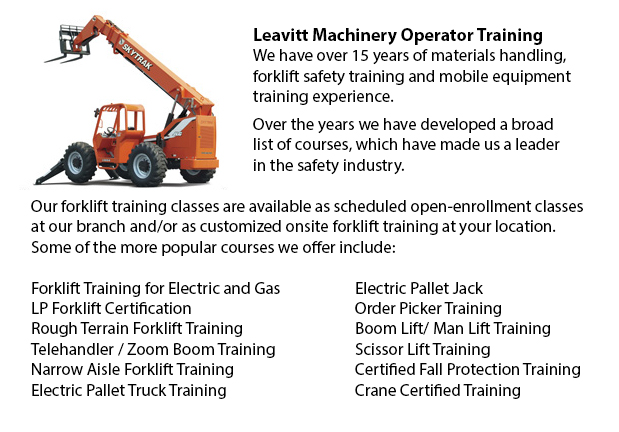
Hamilton Zoom Boom Training - Zoom Boom Training focuses on properly training prospective operators on variable reach forklifts. The training goals consist of gaining the understanding of the machine's physics and to be able to define the responsibilities of the operator. This course abides by North American safety standards for lift trucks. Zoom boom training and certification is available at the company's location or at our site, provided there are a few trainees. Certification given upon successfully completing it is valid for three years.
A telescopic handler (likewise referred to as a telehandler) is similar in some ways to both a forklift and a crane. It is a useful equipment made with a telescopic boom which can lift upwards and extend forward. Various attachments could be connected on the end of the boom, like bucket, pallet forks, lift table or muck grab. It is popular in agriculture and industry settings.
Telehandlers are most normally utilized along with the fork attachment in order to shuttle loads. The units have the advantage that they can reach places inaccessible to regular forklifts. Telehandlers are capable of removing palletized loads from inside a trailer and placing them on high places like rooftops. For certain applications, they can be a lot more practical and efficient as opposed to a crane.
When lifting loads that are heavy, the telehandler can experience some instability. As the boom is extended very far with a load, the machine would become more unsteady. Counterweights in the rear help, but don't solve the problem. The lifting capacity rapidly decreases as the working radius increases. Various machinery come together with front outriggers which extend the lifting capacity when the equipment is stationary.
A load chart helps the operator to determine whether a given load is too heavy. Factors such as load weight, boom angle and height are calculated. Some telehandlers have sensors which cut off further control or provide a warning if the unit is in danger of destabilizing.
-
Hamilton Aerial Platform Training
Hamilton Aerial Platform Training - Aerial hoists are able to accommodate various odd jobs involving high and hard reaching spaces. Often utilized to perform routine repair in structures with high ceilings, prune tree branches, hoist heavy shelving u... More -
Hamilton Heavy Equipment Operator Certification
Hamilton Heavy Equipment Operator Certification - The heavy equipment operator is a person who manipulates the controls and drives different kinds of big machinery. Heavy machinery is most commonly utilized on construction sites to deliver supplies t... More -
Hamilton Scissor Lift Ticket
Hamilton Scissor Lift Ticket - Scissor lifts have greatly benefited construction operations in view of the fact that the job that used to require much effort and lots of people, can now be completed utilizing the scissor lift truck and only one indiv... More -
Hamilton Forklift Certification Courses
Hamilton Forklift Certification Courses - Forklift certification courses really help to make sure that businesses utilizing forklifts, comply with the regional and local rules. The drivers of the forklift should undergo forklift certification prior t... More -
Hamilton Forklift Training Program
Hamilton Forklift Training Program - The forklift is a common powered industrial vehicle which is in wide use these days. They are occasionally called jitneys, hi los or lift trucks. A departments store would use the forklift to unload and load merch... More -
Hamilton Forklift License
Hamilton Forklift License - Obtaining a forklift license or forklift certification in North America would require the trainee to do hands-on training in addition to classroom instruction. The state, provincial and federal regulatory bodies are respon... More -
Hamilton Manlift Operator Certification
Hamilton Manlift Operator Certification - Our aerial lift and scissor platform training and certification empowers participants with a general understanding and knowledge of the efficient and safe use of "Power Operated Mobile Work Platforms," under... More -
Hamilton Forklift Operator Certification
Hamilton Forklift Operator Certification - Forklift operator certification is usually needed for employees working in industrial, warehouse or construction setting to guarantee the safe utilization of forklifts. Workplace training has to follow a met... More

Forklift Certification Hamilton
TOLL FREE: 1-888-254-6157
Hamilton, Ontario
forkliftcertificationhamilton.com
Email Us
About Us


